|
OOC
Volvo B7TL/East Lancs Mylennium Vyking London General
Following
on from his review of the First of the East Lancs casting OM42501
DAF/Lowlander in Ipswich Buses Centenary livery Mark
Smith has very kindly written a further review for the second model in the
series:
"Hot
on the heals of the DAF/Lowlander in Ipswich Buses Centenary livery comes
the second casting variation of the OOC East Lancs ‘modern’ casting,
this time representing London General Transport Services Volvo B7TL EVL43
(PJ02 PZA)
In
my review of the Ipswich DAF I highlighted a number of disappointing
inaccuracies, which I hoped would be corrected on later offerings.
So how does this one compare? The
B7TL model has a number of detail differences from the DAF, notably dual
doors, a rear lower deck window, glazed rear route number box and revised
rear emergency door, which are correctly different from the Ipswich DAF.
Scale
wise, compared to an East Lancs drawing of the prototype, the chassis and
body dimensions are accurate for the low-height DAF/Lowlander, and therefore
the wheelbase and rear overhang dimensions are slightly wrong for the B7TL
– however the difference in 1/76 scale is minimal and this does not
detract from the model. Similarly,
the overall height is correct for this model, being a lowheight (4.2m)
offering, with equal height windows on both decks.
As mentioned in the Ipswich DAF review, the front end of the casting
is compromised by thick front pillars.
These presumably give structural strength to the model.
Generally the casting generally relies on printed detail rather than
moulded relief. Even though
some of the characteristic horizontal panel joins are depicted as moulded
relief, the thin black plastic mouldings inset into them at cant and waist
levels are not printed on, and they are incorrectly left in the main body
colour. The model is fitted
with separate moulded mirrors, etched windscreen wipers and an etched tree
bar (actually fitted to this prototype, unlike the Ipswich DAF).
The interior is light grey with seats sprayed a reddish-brown, and is
reasonably accurate.
In
terms of livery, the colours are accurate and well applied, with excellent
details including the fuel filler number on the staircase panel, fleet names,
numbers, nearside door button, wheelchair symbols and grilles appropriate to
a B7. However, there are more
obvious errors that reference to photographs in any number of publications
highlight. These include:
·
Volvo
and TfL/wheelchair logos missing on the front
·
Yellow
stripe over grey skirt omitted from offside front panel under cab and
offside rear engine door (but carried on the opposite side and back!
·
Prominent
tinted front upper deck window omitted
·
No
depiction of prominent yellow handrails on doors, windows etc
·
Offside
legal lettering present (should be nearside only)
·
Front
destination blinds too wide and ultimate blind to shallow
Worst
of all, once again the printed side window pillars are far too thick; my
East Lancs drawing scale these at approx 1mm wide.
The model versions are nearly 4mm wide, and consequently the windows
are not quite wide enough.
I
would say this model captures the character of the Volvo rather better than
the Ipswich DAF, though this is probably down to the livery application more
than anything else. It still
surprises me that models costing well over £20 are little more than moulded
boxes with printed details, and fail to completely capture the elusive
‘character’ of the prototype. If
Corgi can produce a magnificent model of something built around seventy
years ago, such as the AEC Q, they should be able to do better with a square
box that is still being built today!"
This review is © Mark
Smith 6 September 2003
|


